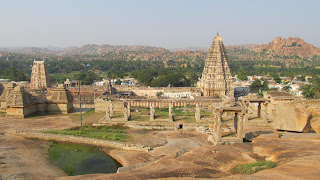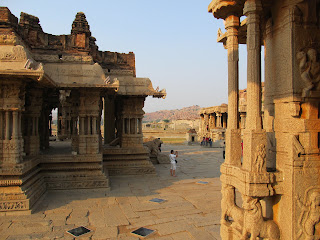 This place is almost unbelievable. The boldness of its beauty is just breathtaking. The heart feels overwhelmed. Hampi , as it is now, is just a small village, there is a bazaar with narrow streets that feel cluttered and erratic, lined with cows and small shops selling jewellery, clothes and general commodities, a few guest houses and very little happening, but there is a sense of serenity here, and calmness that rests on the soul upon arrival.The place feels quite surreal, and I finally feel I am getting closer to the Indian experience. From the motorised buzzing of the yellow and black rickshaws that chase the tourists around, to the magic baba’s with painted faces and orange robes, plucking golden trinkets from thin air, coughing up huge stones and the village elephant decorated with colourful painted patterns. All the senses are tantalised. There are the sounds of a procession, trumpets, flutes and drums as they meander around the village announcing the marriage of a young couple, the music lasting three days (there have also been the sounds of their arguments when the alcohol has got too much and the women and men screech ‘you bitch’ at each other in their local language from the roof tops). There are smells of sandalwood and jasmine as thick whorls of joss stick smoke twist from the houses and restaurants into the street. The feel of children as they run up to touch the skin of a strange white giant. The taste of real Indian cooking, not food adjusted for the sensitivities of the westerner, but spices that set the lips tingling like hot coals, and chilli that builds an inferno in the mouth long after the meal is over. And there is the visuals, oh, my weary, happy eyes.The world here seems vibrant and fantastically peculiar.
This place is almost unbelievable. The boldness of its beauty is just breathtaking. The heart feels overwhelmed. Hampi , as it is now, is just a small village, there is a bazaar with narrow streets that feel cluttered and erratic, lined with cows and small shops selling jewellery, clothes and general commodities, a few guest houses and very little happening, but there is a sense of serenity here, and calmness that rests on the soul upon arrival.The place feels quite surreal, and I finally feel I am getting closer to the Indian experience. From the motorised buzzing of the yellow and black rickshaws that chase the tourists around, to the magic baba’s with painted faces and orange robes, plucking golden trinkets from thin air, coughing up huge stones and the village elephant decorated with colourful painted patterns. All the senses are tantalised. There are the sounds of a procession, trumpets, flutes and drums as they meander around the village announcing the marriage of a young couple, the music lasting three days (there have also been the sounds of their arguments when the alcohol has got too much and the women and men screech ‘you bitch’ at each other in their local language from the roof tops). There are smells of sandalwood and jasmine as thick whorls of joss stick smoke twist from the houses and restaurants into the street. The feel of children as they run up to touch the skin of a strange white giant. The taste of real Indian cooking, not food adjusted for the sensitivities of the westerner, but spices that set the lips tingling like hot coals, and chilli that builds an inferno in the mouth long after the meal is over. And there is the visuals, oh, my weary, happy eyes.The world here seems vibrant and fantastically peculiar.
We are staying in a brightly (a bit too brightly) coloured guest house by the river next to the bazaar. In the mornings the villagers head down to the river to wash themselves and their clothes. The river is accessed by a grand set of ancient steps that boast the importance of water, and the river itself has to be one of the most sightly rivers I have seen. The width is only around 20 metres, but it curves subtly with the calmly flowing water, easing itself around large boulders and gently wending into the distance. And it is the boulders that give Hampi its beauty. As far as the eye can see there are jumbled hills covered in huge rocks, many as big as houses, interspersed with palms, where they found gaps in between the big, big stones. The rocks are piled high on top of one another, some seeming to defy gravity, others, somehow weathered so the underside has been eroded and the boulder rests precariously on a miniscule, natural, plinth. The colours of them are warm too. Shades of orange ranging from those with a pinkish hue through to hints of brown that meld across the cool grey of the rocks.I feel my words to the natural wonder of this place are no justice. Sat atop one these boulder strewn hills, looking at the phenomenal landscape, no further explanation is needed to understand why the people of the 13-16th century chose this place to build their monuments to their gods.
 And what monuments they are. As visually impressive as the landscape they are set into. From our guest house it is possible to see the temple to Shiva, a colossal, yet profoundly intricate structure set at the bottom of one of the hills. Its unashamed conspicuousness towering skyward tells of man’s wish to honour the integrity of the surrounding landscape. The reliefs carved from the stones making up the temple show a more liberal and licentious attitude that the ancient Indians had when compared to the prudishness that binds the people in more modern times. The monkeys that scamper around it with seemingly mischievous intent appear more in touch with the essence of the place than the people now living around it.
And what monuments they are. As visually impressive as the landscape they are set into. From our guest house it is possible to see the temple to Shiva, a colossal, yet profoundly intricate structure set at the bottom of one of the hills. Its unashamed conspicuousness towering skyward tells of man’s wish to honour the integrity of the surrounding landscape. The reliefs carved from the stones making up the temple show a more liberal and licentious attitude that the ancient Indians had when compared to the prudishness that binds the people in more modern times. The monkeys that scamper around it with seemingly mischievous intent appear more in touch with the essence of the place than the people now living around it. There are many other temples and small buildings around Hampi, there is a circuit of around 12 km in which they are all contained. There are many much smaller monuments that, although built with grandeur and flair, regardless of their scale, all of them seem to fit harmoniously into the environment. They are sat upon the boulders, around them and somehow with them. Maybe it is because the Hindu’s incorporate many elements of nature within their belief system that they were able to build something so in-tune with the scenery it is set in. There are temples dedicated to Ganesh the elephant headed god, Hanuman, the monkey-man god, and to the many incarnations of Shiva, Vishnu and Krishna. There are also Islamic mahal’s and mosques, grand stables to house elephants and bazaar upon bazaar, where simple columned structures are lined into the distance from the entrance to the temples. In the Hampi bazaar these old columns are still being used. People have filled in the gaps and turned them into houses and shops. This absorption of the ancient into present day shows continuity, there seems to be something quite honest about using these buildings for practical purposes rather than just to admire.
There are many other temples and small buildings around Hampi, there is a circuit of around 12 km in which they are all contained. There are many much smaller monuments that, although built with grandeur and flair, regardless of their scale, all of them seem to fit harmoniously into the environment. They are sat upon the boulders, around them and somehow with them. Maybe it is because the Hindu’s incorporate many elements of nature within their belief system that they were able to build something so in-tune with the scenery it is set in. There are temples dedicated to Ganesh the elephant headed god, Hanuman, the monkey-man god, and to the many incarnations of Shiva, Vishnu and Krishna. There are also Islamic mahal’s and mosques, grand stables to house elephants and bazaar upon bazaar, where simple columned structures are lined into the distance from the entrance to the temples. In the Hampi bazaar these old columns are still being used. People have filled in the gaps and turned them into houses and shops. This absorption of the ancient into present day shows continuity, there seems to be something quite honest about using these buildings for practical purposes rather than just to admire.
The most impressive of the temples is the Vittal, more for the size of the complex than the craftsmanship, which is as intricate and as splendid there as the other large temples in the area. On walking into the entrance the visitor is greeted by a huge stone chariot, which apparently functioned as a moving vehicle at one point, which on seeing the density of stone sat upon the beautifully carved wheels seems impossible, but India seems to be the place where the impossible can happen. There are pillars and shrines, all carved with such delicacy and beauty it is, after a whole day of looking at these wonders, exhausting to the eye.
We hired push-bikes for the day to explore the ancient complex which was the perfect way to see the sights. It was a leisurely tour through the majesty of nature and man combined. I have been here for three days now and still feel overwhelmed by the immensity of the place. We have sat in the shade of decadent temples, and wondered at the precariousness of the huge rocks as we rode past them. And the place, at the moment, is quiet too. There is no bustle of people being shuffled around; some places, being devoid of anyone but us, which means we could sit and feel the place envelope us in its grandeur.
There is also one of the loveliest places to see the sunset I have ever been to. There is a hill next to the Shiva temple near our guest house, which is littered with spectacular boulders and ancient monuments, at the top of which, is a large boulder jutting out over an edge. Sitting at the end of this boulder and watching the sun set behind the irregular hills, the reds and purples spewing gloriously into the darkening clouds, and the silhouettes of bats over a metre in span passing with strong beats of their wings, is a treasure no money can buy.




mmmm...NOW Im feeling envious! A thought occurs to me..are all the temples/religious buildings historic? I presume that unlike, say, St.Peters in Rome, or Westminster cathedral which though historic are still in use as religious houses, the temples you are seeing no longer function to serve religious aspiration. What do modern Hindus use for their worship?
ReplyDeleteThis is a reply. See below for the reply I made at the time, obviously ineptly!
Deletehttp://video.google.com/videoplay?docid=-521537373096312859#docid=-2599561260535868768
ReplyDeleteYou might like to check this out :-)
It was a truely wonderful place, and I would have no hesitation about going back there. As for the temples, the one in the main bazaar is still used as a temple. But generally the Hindu's tend to build these gaudy monstrosoties wildly coloured in salmon pinks, sky blues and buttercup yellows, with characitures of their gods in cheap plaster adroning the outsides. Nothing like the majesty of Hampi.
ReplyDelete